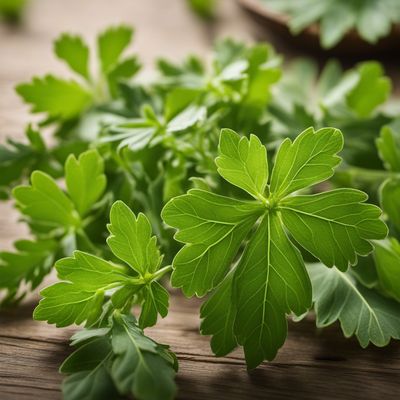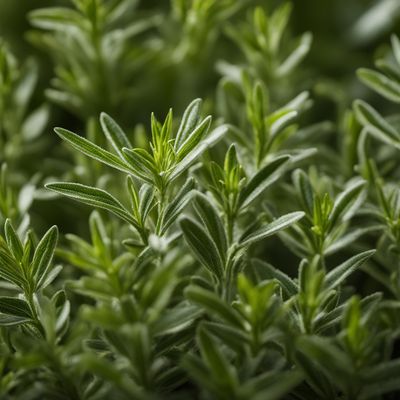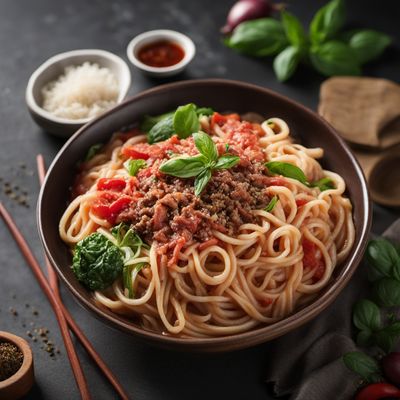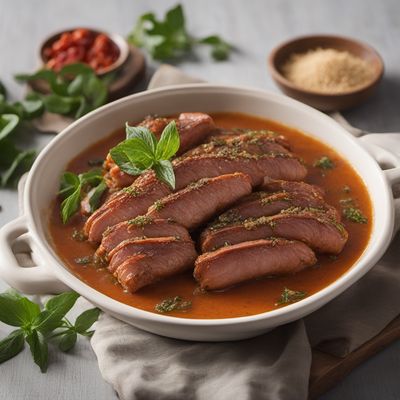
Ingredient
Basil, dry
The Fragrant Herb: Dried Basil
Dried basil is derived from the leaves of the basil plant, which are carefully dried to preserve their aromatic and savory qualities. It possesses a slightly sweet and peppery taste with hints of mint and anise. The texture is crumbly and brittle, and the appearance showcases vibrant green leaves.
Origins and history
Basil has its roots in the Mediterranean region, particularly in India and Iran, where it has been cultivated for over 5,000 years. It holds immense cultural significance in Italian cuisine, often associated with pesto and tomato-based dishes. Basil was also revered in ancient civilizations like Egypt and Greece for its medicinal properties and religious symbolism.
Nutritional information
Dried basil is a good source of vitamin K, iron, calcium, and antioxidants. It is low in calories, with approximately 4 calories per teaspoon.
Allergens
There are no known allergens associated with dried basil.
How to select
When selecting dried basil, opt for a reputable brand that ensures high-quality herbs. Look for vibrant green leaves without any signs of discoloration or moisture. The aroma should be strong and fragrant.
Storage recommendations
To maintain the freshness of dried basil, store it in a cool, dark place, away from heat and moisture. Use a tightly sealed container to prevent the loss of flavor and aroma.
How to produce
Dried basil can be easily produced by harvesting fresh basil leaves and drying them in a well-ventilated area away from direct sunlight. Once completely dry, crumble the leaves and store them in an airtight container.
Preparation tips
Dried basil can be used in a variety of dishes, including soups, stews, sauces, marinades, and salad dressings. It pairs well with tomatoes, garlic, lemon, and olive oil. Sprinkle it over pizzas, pasta dishes, or roasted vegetables for an extra burst of flavor.
Substitutions
Dried oregano or thyme can be used as substitutes for dried basil, although they have slightly different flavor profiles. Fresh basil leaves can also be used as a substitute, but the quantity may need to be adjusted as dried basil is more concentrated.
Culinary uses
Dried basil is commonly used in Italian, Mediterranean, and Thai cuisines. It is a key ingredient in pesto, Caprese salad, tomato-based sauces, and bruschetta. It also adds a delightful flavor to grilled meats, seafood, and roasted vegetables.
Availability
Dried basil is widely available in grocery stores, supermarkets, and online retailers.
More ingredients from this category » Browse all

Bay leaves, dry
Aromatic Leaf of Flavor

Sage, dry
The Timeless Herb: Unveiling the Versatility of Dry Sage

Borage, dry
The Vibrant Herb of Delight

Lovage, dry
The Aromatic Herb: Lovage

Thyme, dry
The Essence of Thyme: A Versatile Herb

Marjoram, dry
Discovering the Aromatic Delights of Dry Marjoram

Sweet cicely, dry
The Delicate Herb: Sweet Cicely

Rosemary, dry
"The Fragrant Herb: Unveiling the Secrets of Dried Rosemary"

Angelica, dry
The Heavenly Herb: Unveiling the Secrets of Dry Angelica

Fennel, dry
The Fragrant Spice of the Mediterranean

Savory, dry
Umami Delight

Celery leaves, dry
The Flavorful Herb: Dry Celery Leaves
Recipes using Basil, dry » Browse all

Homemade Spiced Beef Sticks
Savory South African Beef Delight

Croatian-style Sushi
Adriatic Roll

Creamy Pea Soup
Velvety Green Delight: Creamy Pea Soup

New York-Style Pizza
Mediterranean Twist on Classic New York-Style Pizza

Bermudian Masnica Delight
Savory Bermudian Twist on Ogulinska Masnica

Homestyle Italian-American Spaghetti and Meatballs
Savory Delights: Homestyle Italian-American Spaghetti and Meatballs

Neapolitan-style Kijoyu Udon
Savory Tomato Udon with a Neapolitan Twist

Homemade Prosciutto Pizza
Savory Delight: Homemade Prosciutto Pizza

Homemade Cheesy Pepperoni Stromboli
Savory Italian Delight: Cheesy Pepperoni Stromboli

Pizza Margherita
Dutch-inspired Margherita Pizza

St. Louis Style Cotechino Modena
Savory St. Louis Sausage Delight

Sicilian-Inspired Braised Beef with Sweet and Sour Sauce
Sicilian Beef Stew: A Tangy Twist on Braised Meat